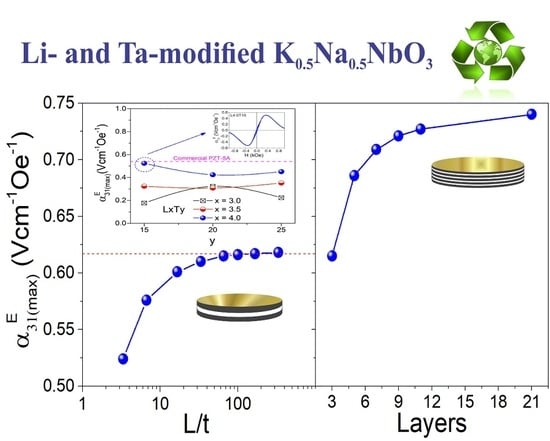Selection and Optimization of a K0.5Na0.5NbO3-Based Material for Environmentally-Friendly Magnetoelectric Composites
Abstract
:1. Introduction
2. Methods
2.1. Preparation and Characterization of the LKNNT Materials
2.2. Simulation of the ME Response of Model Composite Layered Structures
3. Results and Discussion
3.1. Preparation and Characterization of the LKNNT Materials
3.2. Simulation of Model Composite Layered Structures Including the LKNNT Materials
4. Summary and Conclusions
Author Contributions
Funding
Acknowledgments
Conflicts of Interest
References
- Fiebig, M. Revival of the magnetoelectric effect. J. Phys. D Appl. Phys. 2005, 38, R123–R152. [Google Scholar] [CrossRef]
- Hu, J.M.; Chen, L.Q.; Nan, C.W. Multiferroic Heterostructures Integrating Ferroelectric and Magnetic Materials. Adv. Mater. 2015, 28, 15–39. [Google Scholar] [CrossRef] [PubMed]
- Palneedi, H.; Annapureddy, V.; Priya, S.; Ryu, J. Status and Perspectives of Multiferroic Magnetoelectric Composite Materials and Applications. Actuators 2016, 5, 9. [Google Scholar] [CrossRef] [Green Version]
- Eerenstein, W.; Mathur, N.D.; Scott, J.F. Multiferroic and magnetoelectric materials. Nature 2006, 442, 759–765. [Google Scholar] [CrossRef]
- Ma, J.; Hu, J.; Li, Z.; Nan, C.W. Recent Progress in Multiferroic Magnetoelectric Composites: From Bulk to Thin Films. Adv. Mater. 2011, 23, 1062–1087. [Google Scholar] [CrossRef] [PubMed]
- Mandal, P.; Pitcher, M.J.; Alaria, J.; Niu, H.; Borisov, P.; Stamenov, P.; Claridge, J.B.; Rosseinsky, M.J. Designing switchable polarization and magnetization at room temperature in an oxide. Nature 2015, 525, 363–366. [Google Scholar] [CrossRef]
- Fernández-Posada, C.M.; Castro, A.; Kiat, J.M.; Porcher, F.; Peña, O.; Algueró, M.; Amorín, H. A novel perovskite oxide chemically designed to show multiferroic phase boundary with room-temperature magnetoelectricity. Nat. Commun. 2016, 7. [Google Scholar] [CrossRef]
- Henrichs, L.F.; Cespedes, O.; Bennett, J.; Landers, J.; Salamon, S.; Heuser, C.; Hansen, T.; Helbig, T.; Gutfleisch, O.; Lupascu, D.C.; et al. Multiferroic Clusters: A New Perspective for Relaxor-Type Room-Temperature Multiferroics. Adv. Funct. Mater. 2016, 26, 2111–2121. [Google Scholar] [CrossRef]
- Spaldin, N.A.; Ramesh, R. Advances in magnetoelectric multiferroics. Nat. Mater. 2019, 18, 203–212. [Google Scholar] [CrossRef]
- Vaz, C.A.F.; Hoffman, J.; Ahn, C.H.; Ramesh, R. Magnetoelectric Coupling Effects in Multiferroic Complex Oxide Composite Structures. Adv. Mater. 2010, 22, 2900–2918. [Google Scholar] [CrossRef]
- Dong, S.; Zhai, J.; Li, J.; Viehland, D. Near-ideal magnetoelectricity in high-permeability magnetostrictive/ piezofiber laminates with a (2-1) connectivity. Appl. Phys. Lett. 2006, 89, 252904. [Google Scholar] [CrossRef] [Green Version]
- Silva, M.; Reis, S.; Lehmann, C.S.; Martins, P.; Lanceros-Mendez, S.; Lasheras, A.; Gutiérrez, J.; Barandiarán, J.M. Optimization of the Magnetoelectric Response of Poly(vinylidene fluoride)/Epoxy/ Vitrovac Laminates. ACS Appl. Mater. Interfaces 2013, 5, 10912–10919. [Google Scholar] [CrossRef] [PubMed]
- Park, C.S.; Priya, S. Cofired Magnetoelectric Laminate Composites. J. Am. Ceram. Soc. 2010, 94, 1087–1095. [Google Scholar] [CrossRef]
- Rödel, J.; Jo, W.; Seifert, K.T.P.; Anton, E.M.; Granzow, T.; Damjanovic, D. Perspective on the Development of Lead-free Piezoceramics. J. Am. Ceram. Soc. 2009, 92, 1153–1177. [Google Scholar] [CrossRef]
- Villafuerte-Castrejón, M.; Morán, E.; Reyes-Montero, A.; Vivar-Ocampo, R.; Peña-Jiménez, J.A.; Rea-López, S.O.; Pardo, L. Towards Lead-Free Piezoceramics: Facing a Synthesis Challenge. Materials 2016, 9, 21. [Google Scholar] [CrossRef] [PubMed] [Green Version]
- Silva, P.; Diaz, J.; Florêncio, O.; Venet, M.; M’Peko, J. Analysis of the Phase Transitions in BNT-BT Lead-Free Ceramics Around Morphotropic Phase Boundary by Mechanical and Dielectric Spectroscopies. Arch. Metall. Mater. 2016, 61, 17–20. [Google Scholar] [CrossRef] [Green Version]
- Zhang, Y.; Sun, H.; Chen, W. A brief review of Ba(Ti0.8Zr0.2)O3–(Ba0.7Ca0.3)TiO3 based lead-free piezoelectric ceramics: Past, present and future perspectives. J. Phys. Chem. Solids 2018, 114, 207–219. [Google Scholar] [CrossRef]
- Liu, W.; Ren, X. Large Piezoelectric Effect in Pb-Free Ceramics. Phys. Rev. Lett. 2009, 103. [Google Scholar] [CrossRef] [Green Version]
- Saito, Y.; Takao, H.; Tani, T.; Nonoyama, T.; Takatori, K.; Homma, T.; Nagaya, T.; Nakamura, M. Lead-free piezoceramics. Nature 2004, 432, 84–87. [Google Scholar] [CrossRef]
- Rödel, J.; Webber, K.G.; Dittmer, R.; Jo, W.; Kimura, M.; Damjanovic, D. Transferring lead-free piezoelectric ceramics into application. J. Eur. Ceram. Soc. 2015, 35, 1659–1681. [Google Scholar] [CrossRef]
- Guo, Y.; Kakimoto, K.I.; Ohsato, H. Phase transitional behavior and piezoelectric properties of (Na0.5K0.5)NbO3–LiNbO3 ceramics. Appl. Phys. Lett. 2004, 85, 4121–4123. [Google Scholar] [CrossRef]
- Wang, X.; Wu, J.; Xiao, D.; Zhu, J.; Cheng, X.; Zheng, T.; Zhang, B.; Lou, X.; Wang, X. Giant Piezoelectricity in Potassium–Sodium Niobate Lead-Free Ceramics. J. Am. Chem. Soc. 2014, 136, 2905–2910. [Google Scholar] [CrossRef] [PubMed]
- Saito, Y.; Takao, H. High Performance Lead-free Piezoelectric Ceramics in the (K,Na)NbO3–LiTaO3 Solid Solution System. Ferroelectrics 2006, 338, 17–32. [Google Scholar] [CrossRef]
- Mazuera, A.M.; Silva, P.S.; Rodrigues, A.D.; Pizani, P.S.; Romaguera-Barcelay, Y.; Venet, M.; Algueró, M. Origin of discrepancy between electrical and mechanical anomalies in lead-free (K,Na)NbO3-based ceramics. Phys. Rev. B 2016, 94. [Google Scholar] [CrossRef] [Green Version]
- Zhou, J.J.; Li, J.F.; Wang, K.; Zhang, X.W. Phase structure and electrical properties of (Li,Ta)-doped (K,Na)NbO3 lead-free piezoceramics in the vicinity of Na/K = 50/50. J. Mater. Sci. 2011, 46, 5111–5116. [Google Scholar] [CrossRef]
- Chang, Y.; Yang, Z.P.; Ma, D.; Liu, Z.; Wang, Z. Phase transitional behavior, microstructure, and electrical properties in Ta-modified [(K0.458Na0.542)0.96Li0.04]NbO3 lead-free piezoelectric ceramics. J. App. Phys. 2008, 104, 024109. [Google Scholar] [CrossRef]
- Guo, Y.; Kakimoto, K.I.; Ohsato, H. (Na0.5K0.5)NbO3–LiTaO3 lead-free piezoelectric ceramics. Mater. Lett. 2005, 59, 241–244. [Google Scholar] [CrossRef]
- Jaffe, B.; Cook, W.; Jaffe, H. Piezoelectric Ceramics; Non-Metallic Solids; Academic Press: Cambridge, MA, USA, 1971. [Google Scholar] [CrossRef]
- Du, H.; Li, Z.; Tang, F.; Qu, S.; Pei, Z.; Zhou, W. Preparation and piezoelectric properties of (K0.5Na0.5)NbO3 lead-free piezoelectric ceramics with pressure-less sintering. Mater. Sci. Eng. B 2006, 131, 83–87. [Google Scholar] [CrossRef]
- Skidmore, T.; Milne, S. Phase development during mixed-oxide processing of a [Na0.5K0.5NbO3]1−x– [LiTaO3]x powder. J. Mater. Res. 2007, 22, 2265–2272. [Google Scholar] [CrossRef]
- Wang, Y.; Damjanovic, D.; Klein, N.; Hollenstein, E.; Setter, N. Compositional Inhomogeneity in Li- and Ta-Modified (K,Na)NbO3 Ceramics. J. Am. Ceram. Soc. 2007, 90, 3485–3489. [Google Scholar] [CrossRef]
- Jaeger, R.E.; Egerton, L. Hot Pressing of Potassium-Sodium Niobates. J. Am. Ceram. Soc. 1962, 45, 209–213. [Google Scholar] [CrossRef]
- Li, J.F.; Wang, K.; Zhang, B.P.; Zhang, L.M. Ferroelectric and Piezoelectric Properties of Fine-Grained Na0.5K0.5NbO3 Lead-Free Piezoelectric Ceramics Prepared by Spark Plasma Sintering. J. Am. Ceram. Soc. 2006, 89, 706–709. [Google Scholar] [CrossRef]
- Venet, M.; Santa-Rosa, W.; M’Peko, J.C.; Amorín, H.; Algueró, M.; Moreno, R. Controlling colloidal processing of (K,Na)NbO3-based materials in aqueous medium. J. Eur. Ceram. Soc. 2019, 39, 3456–3461. [Google Scholar] [CrossRef]
- Rubio-Marcos, F.; Romero, J.; Martín-Gonzalez, M.; Fernández, J. Effect of stoichiometry and milling processes in the synthesis and the piezoelectric properties of modified KNN nanoparticles by solid state reaction. J. Eur. Ceram. Soc. 2010, 30, 2763–2771. [Google Scholar] [CrossRef] [Green Version]
- Lin, Y.; Zhang, J.; Yang, H.; Wang, T. Excellent piezoelectric and magnetoelectric properties of the (K0.45Na0.55)0.98Li0.02(Nb0.77Ta0.18Sb0.05)O3/Ni0.37Cu0.20Zn0.43Fe1.92O3.88 laminated composites. J. Alloys Compd. 2017, 692, 86–94. [Google Scholar] [CrossRef]
- Santa-Rosa, W.; Venet, M.; M’Peko, J.C.; Amorín, H.; Algueró, M. Processing issues and their influence in the magnetoelectric performance of (K,Na)NbO3/CoFe2O4-based layered composites. J. Alloys Compd. 2018, 744, 691–700. [Google Scholar] [CrossRef] [Green Version]
- Yang, S.C.; Ahn, C.W.; Cho, K.H.; Priya, S. Self-Bias Response of Lead-Free (1−x)[0.948 K0.5Na0.5NbO3–0.052 LiSbO3]-xNi0.8Zn0.2Fe2O4-Nickel Magnetoelectric Laminate Composites. J. Am. Ceram. Soc. 2011, 94, 3889–3899. [Google Scholar] [CrossRef]
- Bichurin, M.I.; Petrov, V.M.; Srinivasan, G. Theory of low-frequency magnetoelectric coupling in magnetostrictive-piezoelectric bilayers. Phys. Rev. B 2003, 68. [Google Scholar] [CrossRef] [Green Version]
- Bichurin, M.; Petrov, V.; Zakharov, A.; Kovalenko, D.; Yang, S.C.; Maurya, D.; Bedekar, V.; Priya, S. Magnetoelectric Interactions in Lead-Based and Lead-Free Composites. Materials 2011, 4, 651–702. [Google Scholar] [CrossRef]
- Fu, J.; Rosa, W.S.; M’Peko, J.C.; Algueró, M.; Venet, M. Magnetoelectric coupling in lead-free piezoelectric Li(K0.5Na0.5)1−xNb1−yTayO3 and magnetostrictive CoFe2O4 laminated composites. Phys. Lett. A 2016, 380, 1788–1792. [Google Scholar] [CrossRef]
- Holland, R.; EerNisse, E. Accurate Measurement of Coefficients in a Ferroelectric Ceramic. IEEE T. Son. Ultrason. 1969, 16, 173–181. [Google Scholar] [CrossRef]
- Santa-Rosa, W.; da Silva, P.S.; M’Peko, J.C.; Amorín, H.; Algueró, M.; Venet, M. Enhanced piezomagnetic coefficient of cobalt ferrite ceramics by Ga and Mn doping for magnetoelectric applications. J. App. Phys. 2019, 125, 075107. [Google Scholar] [CrossRef]
- Ramos, P.; Amorín, H.; Ricote, J.; Castro, A.; Algueró, M. Insights into the Performance of Magnetoelectric Ceramic Layered Composites. J. Compos. Sci. 2017, 1, 14. [Google Scholar] [CrossRef] [Green Version]
- Paula, A.J.; Parra, R.; Zaghete, M.A.; Varela, J.A. Study on the K3Li2Nb5O15 formation during the production of (Na0.5K0.5)(1−x)LixNbO3 lead-free piezoceramics at the morphotropic phase boundary. Solid State Commun. 2009, 149, 1587–1590. [Google Scholar] [CrossRef]
- Moriyama, T.; Kan, A.; Takahashi, S.; Ogawa, H. Dielectric and piezoelectric properties of lead-free K0.5Na0.5NbO3–LiSbO3–Bi0.5Li0.5TiO3 system. J. Ceram. Soc. Jpn. 2014, 122, 398–401. [Google Scholar] [CrossRef] [Green Version]
- Santa-Rosa, W.; Venet, M.; M’Peko, J.C.; Moreno, R.; Amorín, H.; Algueró, M. Environmentally-friendly magnetoelectric ceramic multilayer composites by water-based tape casting. J. Eur. Ceram. Soc. 2019, 39, 1065–1072. [Google Scholar] [CrossRef]
- Hollenstein, E.; Davis, M.; Damjanovic, D.; Setter, N. Piezoelectric properties of Li- and Ta-modified (K0.5Na0.5)NbO3 ceramics. Appl. Phys. Lett. 2005, 87, 182905. [Google Scholar] [CrossRef]
- Rushman, D.F.; Strivens, M.A. The effective permittivity of two-phase systems. Proc. Phys. Soc. 1947, 59, 1011–1016. [Google Scholar] [CrossRef]
- Algueró, M.; Alemany, C.; Pardo, L.; González, A.M. Method for Obtaining the Full Set of Linear Electric, Mechanical, and Electromechanical Coefficients and All Related Losses of a Piezoelectric Ceramic. J. Am. Ceram. Soc. 2004, 87, 209–215. [Google Scholar] [CrossRef]
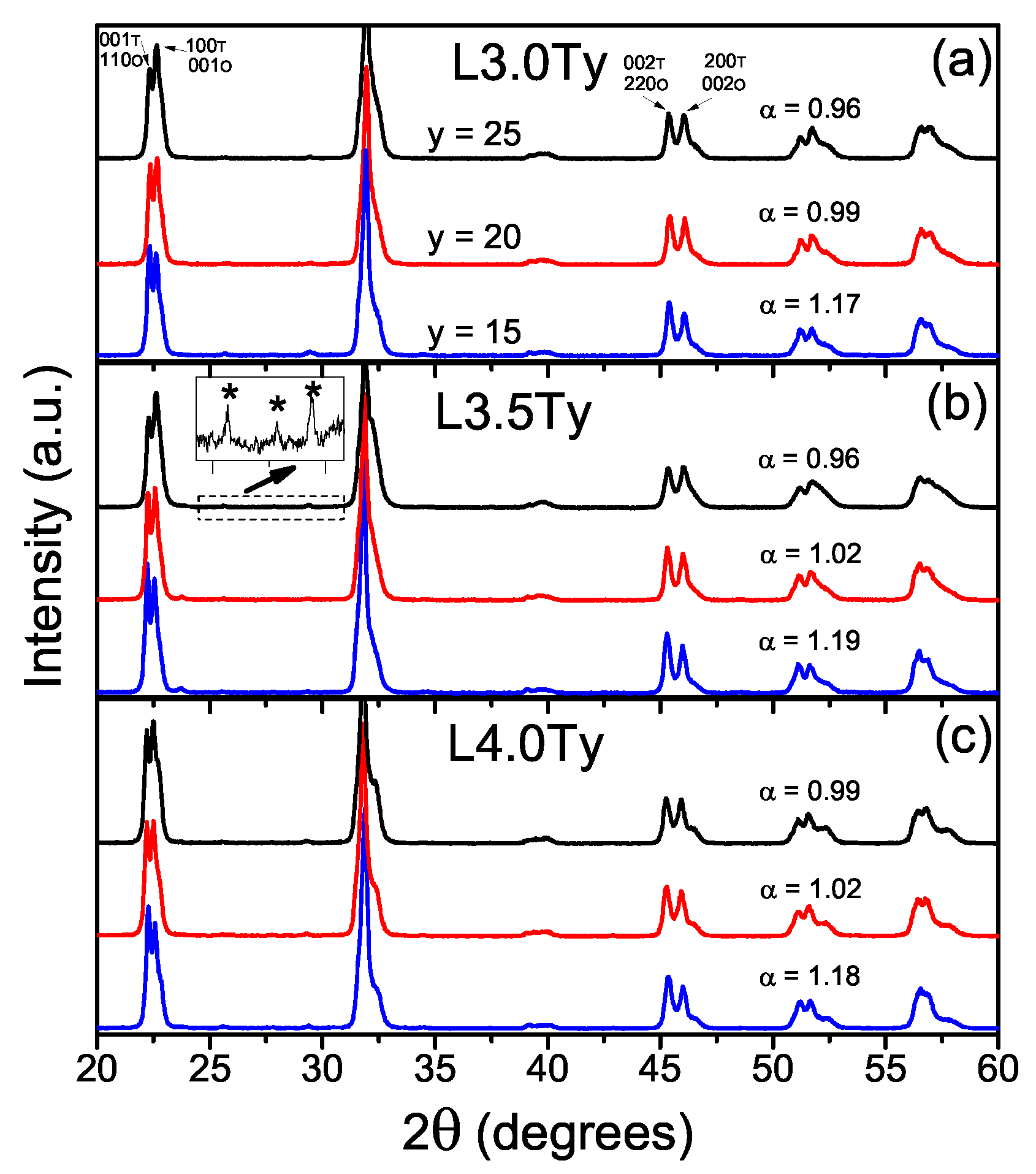
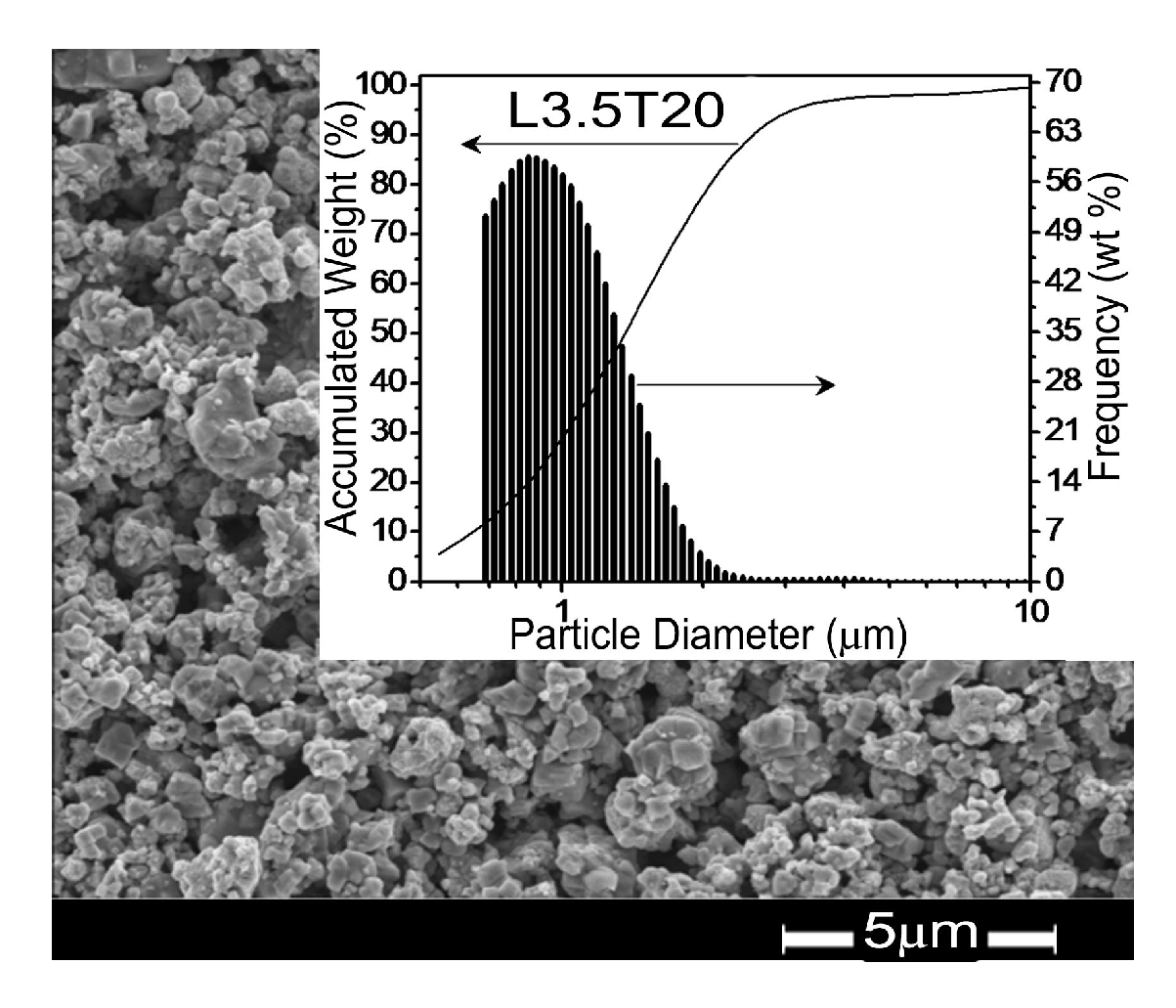
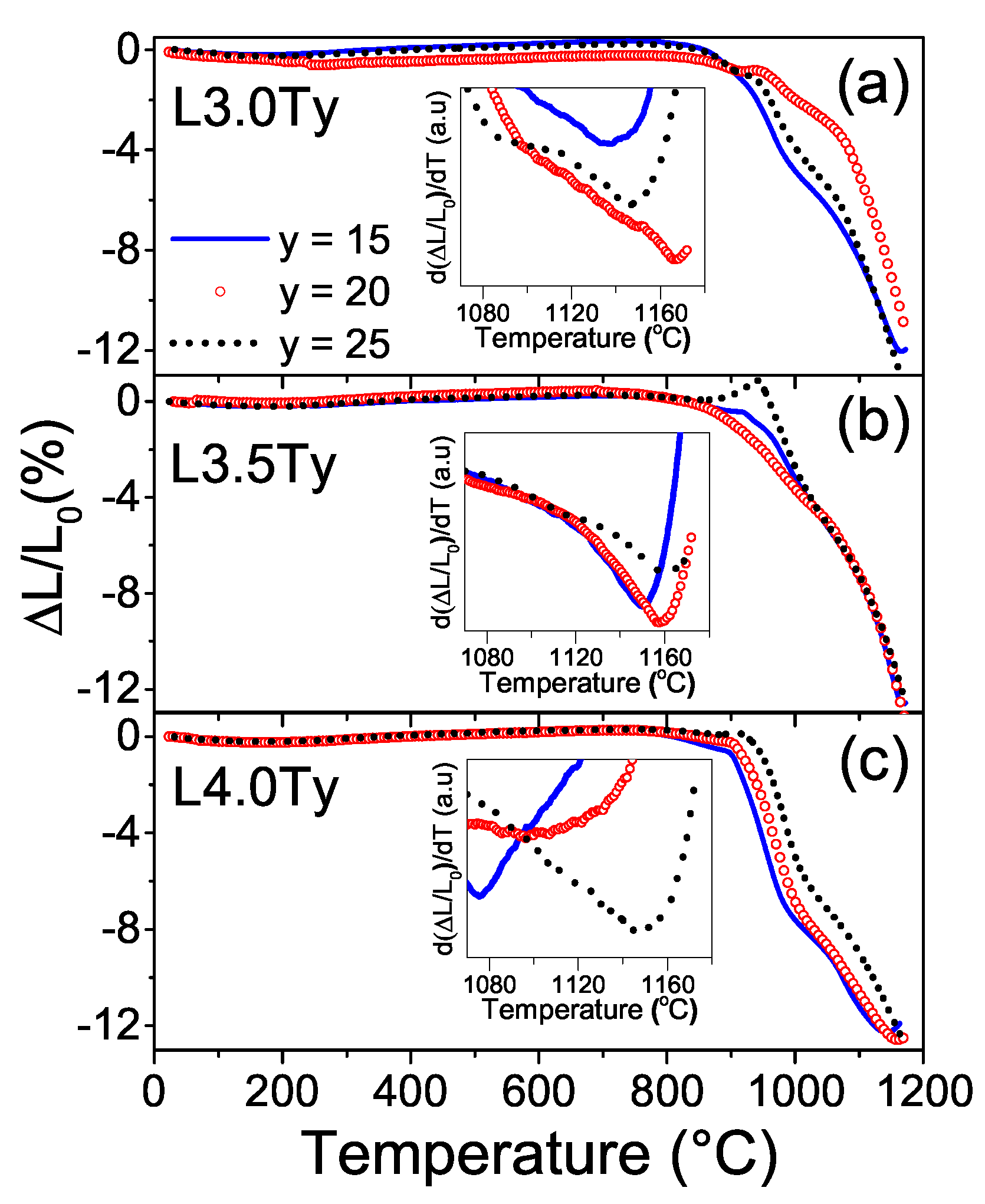

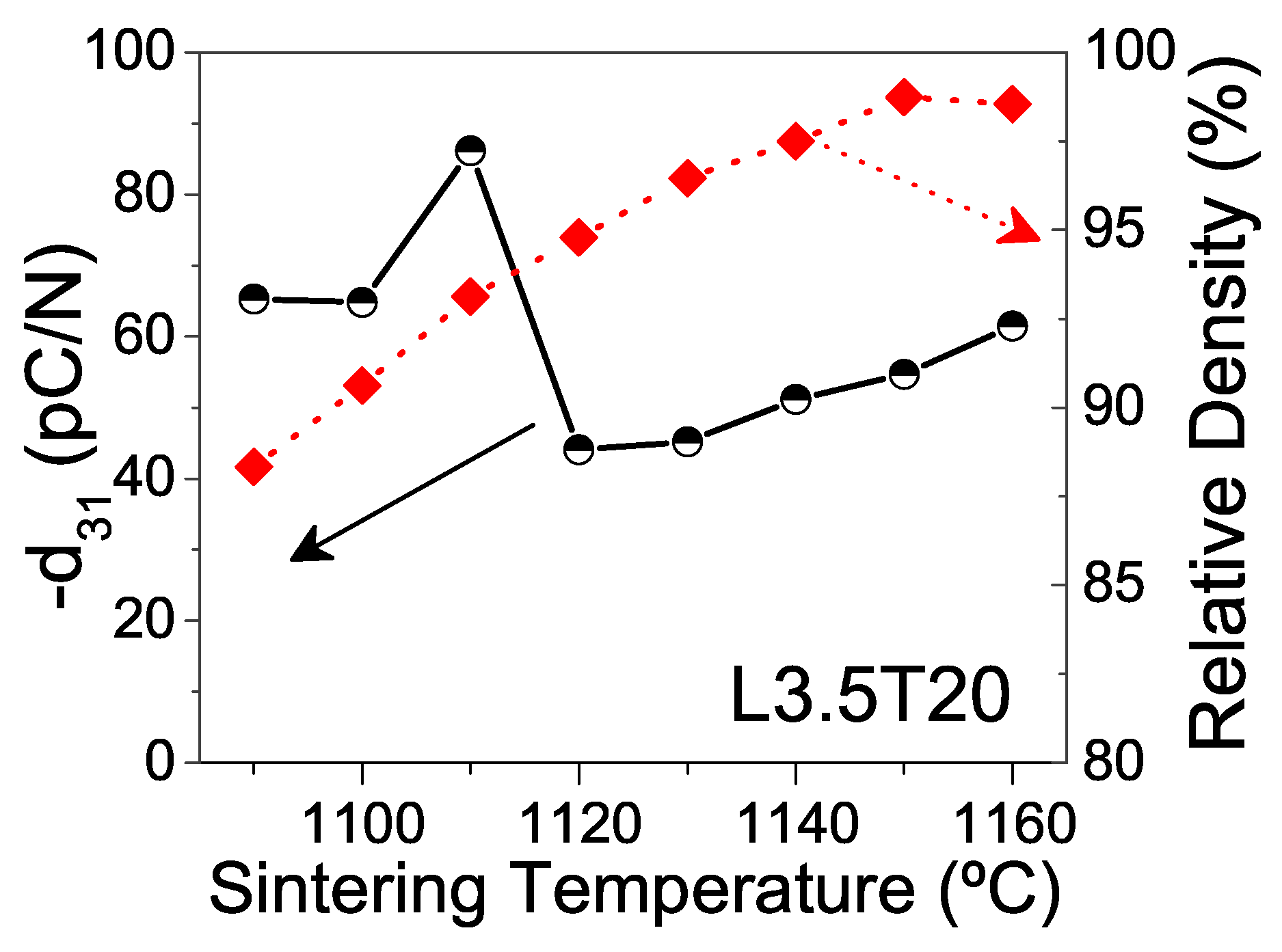




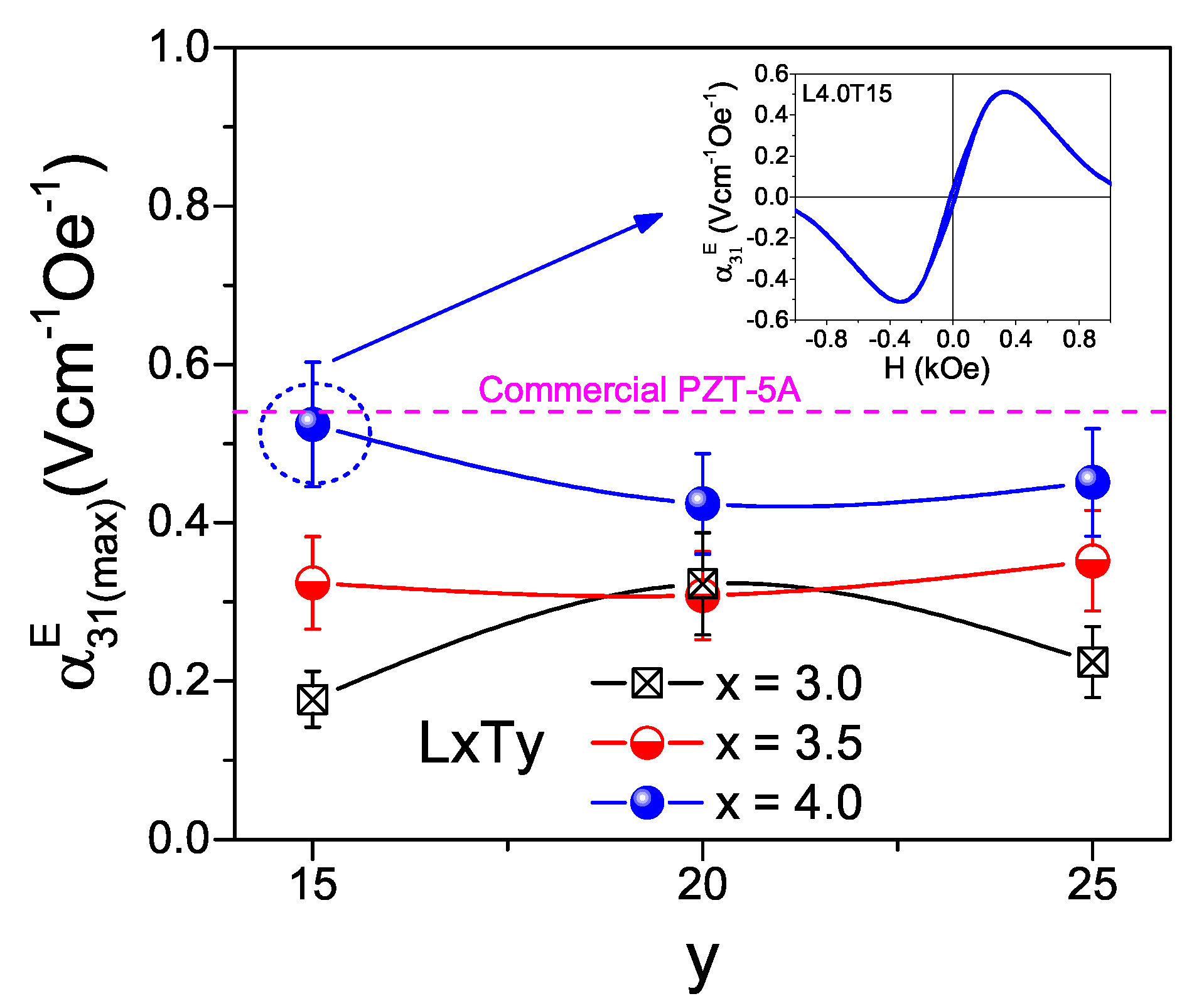
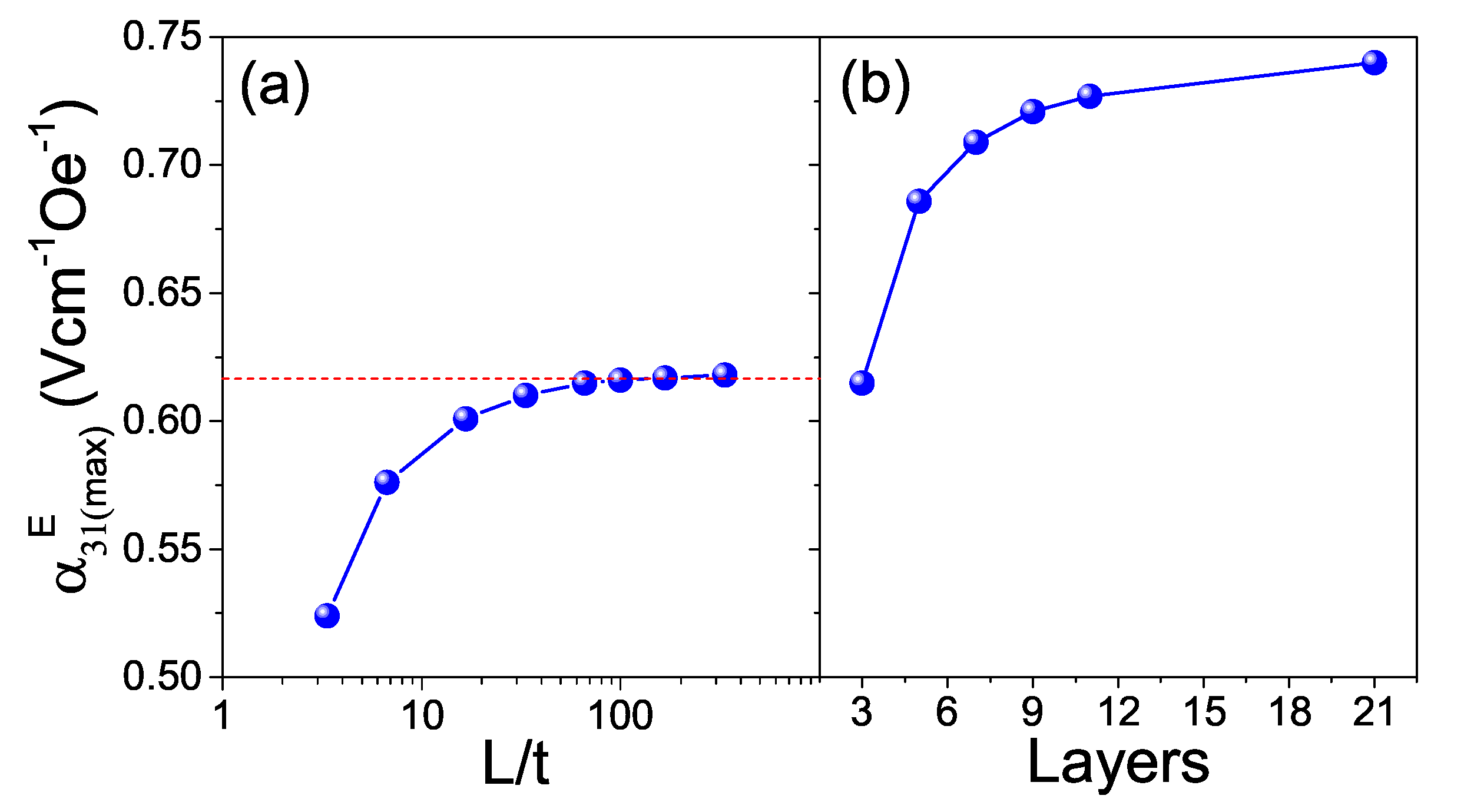
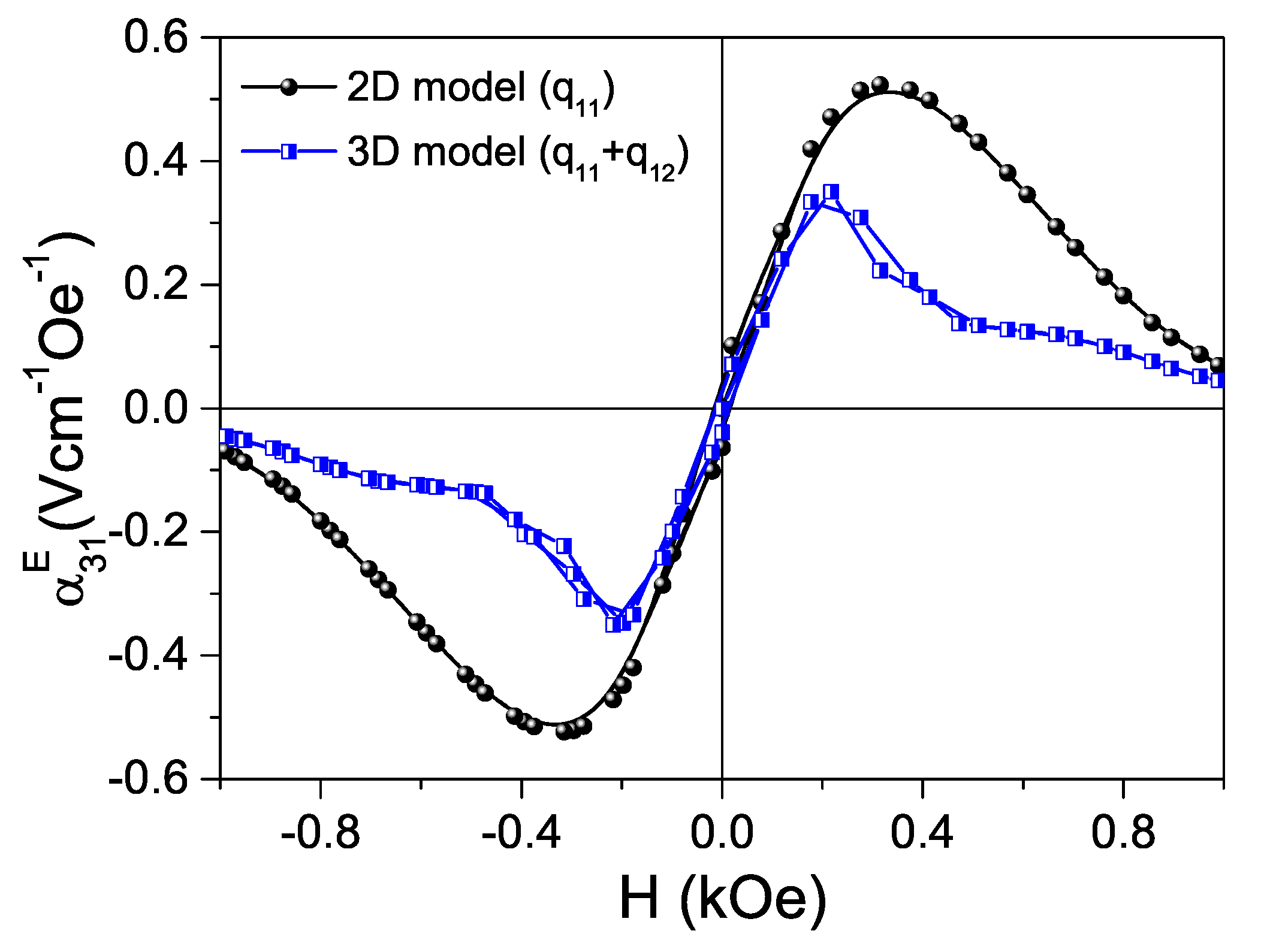
| L3.0Ty | L3.5Ty | L4.0Ty | |
|---|---|---|---|
| y = 15 | 1134 C | 1156 C | 1075 C |
| y = 20 | 1166 C | 1158 C | 1100 C |
| y = 25 | 1147 C | 1160 C | 1150 C |
| Composition | s | s | s + s | d | ||
|---|---|---|---|---|---|---|
| L3.0Ta15 | 9.7 | −3.1 | 6.6 | −51.3 | 1307 | 93.5 |
| L3.0Ta20 | 14.6 | −4.7 | 10.0 | −80.9 | 1281 | 90.7 |
| L3.0Ta25 | 10.6 | −3.4 | 7.2 | −56.8 | 1378 | 91.1 |
| L3.5Ta15 | 9.6 | −3.1 | 6.5 | −46.8 | 862 | 93.3 |
| L3.5Ta20 | 13.9 | −4.5 | 9.5 | −6.1 | 1309 | 93.3 |
| L3.5Ta25 | 11.6 | −3.7 | 7.9 | −73.8 | 1130 | 92.1 |
| L4.0Ta15 | 11.4 | −3.6 | 7.7 | −68.6 | 717 | 94.5 |
| L4.0Ta20 | 12.0 | −3.9 | 8.2 | −95.0 | 1248 | 96.4 |
| L4.0Ta25 | 11.8 | −3.8 | 8.0 | −75.2 | 919 | 92.3 |
| s | s | q | ||||
|---|---|---|---|---|---|---|
| 6.5 | -2.4 | 2.7 | 2 | 10 | 1.2 | 5.23 |
© 2020 by the authors. Licensee MDPI, Basel, Switzerland. This article is an open access article distributed under the terms and conditions of the Creative Commons Attribution (CC BY) license (http://creativecommons.org/licenses/by/4.0/).
Share and Cite
Venet, M.; Santa-Rosa, W.; da Silva, P.S., Jr.; M’Peko, J.-C.; Ramos, P.; Amorín, H.; Algueró, M. Selection and Optimization of a K0.5Na0.5NbO3-Based Material for Environmentally-Friendly Magnetoelectric Composites. Materials 2020, 13, 731. https://doi.org/10.3390/ma13030731
Venet M, Santa-Rosa W, da Silva PS Jr., M’Peko J-C, Ramos P, Amorín H, Algueró M. Selection and Optimization of a K0.5Na0.5NbO3-Based Material for Environmentally-Friendly Magnetoelectric Composites. Materials. 2020; 13(3):731. https://doi.org/10.3390/ma13030731
Chicago/Turabian StyleVenet, Michel, Washington Santa-Rosa, Paulo Sergio da Silva, Jr., Jean-Claude M’Peko, Pablo Ramos, Harvey Amorín, and Miguel Algueró. 2020. "Selection and Optimization of a K0.5Na0.5NbO3-Based Material for Environmentally-Friendly Magnetoelectric Composites" Materials 13, no. 3: 731. https://doi.org/10.3390/ma13030731




